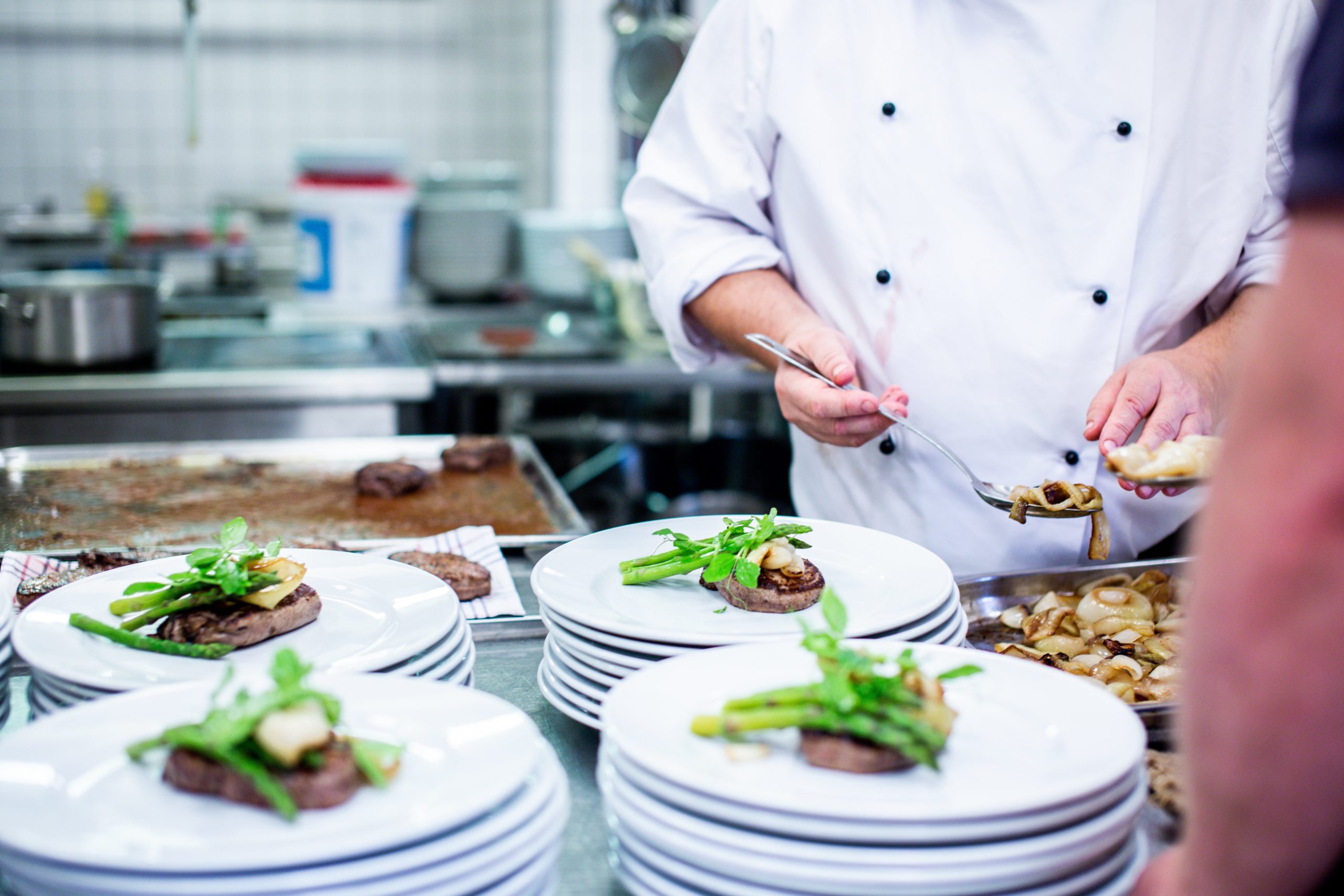Finding the right location, creating the optimal menu, hiring the best staff, marketing — a lot of work goes into formulating a restaurant or food service operation’s business strategy.
Any enterprise’s long-term success largely depends on how well the strategies are developed and thought out, one of the most important elements of which, involves a thorough restaurant competitor analysis.
In this guide, we dig deep into the detailed steps to conduct a thorough competitor analysis in the food industry. We also outline the expectations you need to keep in mind when preparing to face tough competition in the food industry.
Let’s start with the basics.
Competition in the Food Service Industry
The food and beverage industry is incredibly competitive. With estimates of the market reaching $4.4 trillion by 2028, there is no question that the competition in the food industry will only intensify.
While these numbers look promising for upcoming restaurateurs—there is tremendous potential for growth, after all—there’s another side to it. An estimated 80% of restaurants close their shutters before their fifth year.
Fortunately, we’ve got a lead on what the successful 20% are doing right to gain a much-needed competitive advantage.
Competitive Advantages in the Food Service Industry
Knowing what can make a restaurant stand out against the competition in the food industry can make all the difference. Here are three crucial things you must consider closely long before we open your own enterprise:
1. Defining and Understanding the Target Audience
The target audience is the customer group that the business will serve. It can be defined by creating distinct personas for the ideal customer a restaurant is targeting through its aesthetics, ambiance, menu, and marketing endeavors.
A customer persona defines the target audience’s age, gender, occupation, income, and more such demographics. There can be multiple customer personas based on the restaurant’s offerings.
2. Mapping the Market Landscape
Gaining an advantage over the competition in the food industry requires thorough knowledge of the market and current trends. Aspiring restaurant owners must have a clear idea of the current restaurant landscape and identify opportunities and obstacles to their potential success.
Business trends, local restaurant performance, tourism statistics—these details are crucial to determine the accurate market potential of a restaurant concept.

3. Defining the USP and Selling It
A USP or unique selling point, is what makes customers choose a restaurant over its competitors. It is also why they keep returning and recommending it to their family and friends.
The USP can be decided by the owner, or figured out by looking at positive reviews from the customers—it can be anything from the unique ambiance, affordable prices compared to competitors, or plant-based options.
Making a USP a competitive advantage means it has to be well-defined before the restaurant even opens. It will be the central thrust of the business plan and all marketing initiatives.
Restaurant competitor analysis is vital to gather and analyze crucial market data that will help owners accomplish these three important things.
Let’s break down what it entails.
What is a Competitive Analysis?
A competitive analysis is a study involving the identification and assessment of business competitors. The purpose is to assess and analyze the existing competition and develop a business and marketing plan for a brand-new enterprise.
A good restaurant competitor analysis is thorough and assesses all relevant aspects of the competing businesses, such as:
- Features of the product and service offerings
- Menu items
- Strengths and weaknesses
- Differentiators
- Pricing
- Marketing and promotional strategies
- Culture
- Geography
- Market share percentage
- Size
- Target audience
- Reputation
- Cash and assets
- Customer reviews
- Growth potential
- And more.
Such an analysis can be performed when a business needs to evaluate or reevaluate its strategy against its competition in the food industry. Whether a business needs to improve its marketing strategy, enhance product offerings, or work on its weaknesses, a competitive analysis can be of tremendous help.
Importance and Benefits of Performing a Competitive Analysis
Here are some ways in which a competitive analysis may prove useful:
Understanding the Market
The competitive analysis provides a thorough understanding of competitors, customers, and the overall market landscape to gain a competitive advantage.
You can learn what the market is expecting and refine your plan to suit their needs and exceed the competition in the food industry. This can improve your chances of succeeding.
Without learning what the market is, you’re taking a big risk and diving in blind, no matter how good your restaurant concept is.
Identifying Business Strengths and Weaknesses
While a competitive analysis involves studying many different elements of the competitor’s business, it boils down to using the information for yourself.
By studying the strengths and weaknesses of competing restaurants, you learn more about your establishment’s own strengths and weaknesses. This means you can determine where to invest time, money, and effort on improving these elements to succeed.
These details will also help you create a strong business plan, which will attract investors and start the enterprise off on the right foot.
Attracting Investors
Bringing in investors requires a bulletproof business plan based on hard data, which is what a competitive analysis provides.
With a strong understanding of how the market functions and where your restaurant stands in it, you could attract more investors.

Evaluating Industry Trends
The food service industry is changing rapidly, and keeping up is becoming more difficult. This is a problem a competitive analysis can resolve.
With data on local restaurants’ activities and developments in your hands, you’re better prepared to deal with changes in the future.
It is important to analyze this data. A direct competitor performing well in the market is not always a bad sign for your business. In fact, at the base level, this means your business has a chance of succeeding. With more study and strategy, you can even exceed the competition in the food industry.
Planning Future Growth and Development
It can be difficult to scale, plan development goals, or introduce new concepts without analyzing the market. You need proof that your plans and business concepts can succeed in the current market environment, and a restaurant competitor analysis can provide this.
When planning to introduce a new revolutionary concept into the market, seeing how competing businesses are doing will help. Better yet, if a competitor has already implemented said concept into its operations. Regardless of whether the competitor fails or succeeds, it can help you learn what to do and what to avoid.
Looking at the industry as a whole and analyzing emerging trends is a surefire way to develop a future winning strategy. It may also help you become an industry leader.
How to Perform a Competitive Analysis?
While there is no single method of performing a competitive analysis, not having a plan or process can send your study in fruitless directions. To ensure it will be helpful in the decision-making process, there must be a clear strategy.
These steps will make the study more concrete and help you gather data that benefits the restaurant.
-
Identify and List Industry Competitors
Identifying and preparing a list of competitors in the industry is the crucial first step. But not all competitors are the same, which also changes the way you need to study them.
In the food industry, there are two types of competitors: direct and indirect.
Direct Competitors
Direct competition refers to businesses that compete for the same target market and offer very similar products and services.
For example, two fast-casual restaurants with similar menu offerings that cater to the same target market are considered each other’s direct competition in the food industry.
Indirect Competitors
Indirect competitors are businesses catering to the same target market but with different offerings.
For example, consider a pizza parlor and burger shop. Their offerings greatly differ, but because they cater to the same target audience and compete for the same market gap, they are indirect competitors.
You can create two different lists for the two types of competitors and narrow them down by a radius of 10 kilometers.
For restaurants in an urban setting, you can limit the radius to four blocks since people are much more likely to eat at restaurants within walking distance. For restaurants in rural settings, you can widen the radius.
For an efficient restaurant competitor analysis, limiting the number of competitors is best. This means focusing on 10 to 12 of the most relevant direct and indirect competitors.
With a list of competitors on your hands, you can start researching their operations separately. All research must be documented and vetted for later analysis of the competition in the food industry.
Let’s see what areas are worth studying.
-
Analyze the Competitors’ Operations
Here is all the information that should be studied under operational analysis:
- Hours of operation
- Accommodation capacity
- Dining room space
- Cuisine type
- Market saturation (global franchise, umbrella restaurant group, or independent restaurant)
- Services offered (full-service, pickup, delivery, phone-ins, delivery partners, etc.)
- Concept type (fast casual, family style, quick service, cafe, fine dining, etc.)
- Ordering platforms (apps, websites, phones, etc.)
- Date founded
- Ambiance and theme
- Mission statement
- Local partners (breweries, farms, etc.)
- Operational strengths and weaknesses
- Operational threats and opportunities
-
Study Competitors’ Menu

Menu analysis can cover studying the presentational aspects, contents, or both.
- Pricing
- Menu offerings (best sellers, sections, meal descriptions, differentiators, staple dishes, ingredient use, customization options, offers, etc.)
- Seasonal or trending specialties
- Dietary items (for vegans, vegetarians, or those with allergies)
- Menu layout and design
- Appetizers, desserts, beverages, etc.
- Portion sizes
- Crockery, glassware, cutlery, packaging, etc.
- Menu strengths and weaknesses
- Menu opportunities and threats
Finding menu-related information is easier in the digital age, especially with online ordering becoming a popular offer. You can easily check the restaurant’s website and look up customer reviews and social media posts for photos of competitors’ menus and dishes.
-
Study Marketing and Promotional Strategies
This includes learning strategies the competing restaurant uses to attract customers. How are their strategies appealing to their target market? What platforms are they using to promote?
Here are some relevant elements to study:
- Marketing channels (social media, pay-per-click ads, newspaper, TV, radio, etc)
- Marketing presence
- Special events (game nights, live game events, festive-themed dinners on holidays) and other programs
- Current, all-time, and seasonal promotions, marketing events, deals, and dailies
- Marketing strengths and weaknesses
- Marketing opportunities and threats
You can collect marketing and promotional strategies from the competitors’ physical storefronts, restaurant websites, and social media accounts.
-
Analyze Customer Reviews
Many customers visit restaurants after reading positive reviews about them. You can start by reading positive and negative reviews and filtering them based on specific categories:
- Positive customer reviews with 4- and 5-star ratings
- Negative customer reviews with 1-, 2-, and 3-star ratings
- Customer strengths and weaknesses
- Customer opportunities and threats
Reviews can also be sorted based on the restaurant elements they discuss, such as ambiance, quality of dishes, service, prices, convenience, ordering methods, etc.
Sites like Yelp, Zomato, TripAdvisor, OpenTable, and other similar aggregators are good places to get started when gathering customer reviews.
-
Analyze the Service
The service team plays a key role in the overall dining experience. What your competitors’ service team is and isn’t doing right can be another element for you to work on.
Here are the details to be evaluated:
- Service style
- Sales techniques
- Service team knowledge and expertise
- Uniform
- Service strengths and weaknesses
- Service opportunities and threats
You can gather this information by visiting the restaurant and observing the frontline staff interact with customers.
-
Perform a SWOT Analysis
SWOT (strengths, weaknesses, opportunities, and threats) is a method of analysis used in strategic planning and management. It is applied across many industries and is a core element of most business planning processes.
While we have studied some SWOT elements of the menu, marketing, operations, and reviews in the previous steps, this involves a different approach. A SWOT analysis involves comparing the features of competing restaurants against ours. You study how competing restaurants and yours are performing in the market.
Let’s take a look at the factors included in a SWOT analysis and what is studied under them.
Strengths
This covers the well-performing aspects of competition in the food industry. It involves narrowing down successful restaurants and figuring out what they’re doing right. Then, strategize ways to improve your offerings and exceed what they offer.
Weaknesses
This involves looking at competitors’ weaknesses and learning how to avoid those mistakes in our operations. It is important to turn others’ weaknesses into your strengths to maintain a competitive advantage.
You can study restaurants that aren’t performing well or are getting negative responses for some of their offerings.
Opportunities
This involves looking at the big picture of strengths and weaknesses, identifying opportunities available to your business, and finding ways to explore those opportunities.
Threats
Threats include all the strong aspects of competitors that give them a competitive advantage over your establishment. Analyzing threats is useful in formulating ways to put a restaurant on the same level as the competition and match or remove the competitive advantage.
A SWOT analysis will help you learn how your competition in the food industry works. It also informs you of areas you can improve in your business to make it a better proposition for the customer’s needs.
Here are some things you can focus on during your analysis to gain better insight:
- Are competing restaurants performing well in the local market?
- Are there competitors whose businesses are suffering for one reason or another?
- Can you improve the quality of your offerings?
- What are the biggest threats to your business?
- Do you need to consider lowering your prices to maintain a competitive advantage?
- What are the strengths of your business in comparison with others?
- What are the opportunities in the market you can take better advantage of?
- Are there marketing gaps that you can fulfill to gain better ROI?
With these details, you can identify areas that your business can improve on and prepare actionable steps to do so. Then integrate them into the business plan and execute them to their fullest potential.
If you find some restaurants doing exceptionally well, you can use their business model to inspire your own. Comparing all aspects of both of your restaurants will help you see if adapting them will work for you.
Pro tip: Modeling a business plan and strategy on competitors with the most similarities to your business structure works best.
Using Competitive Analysis to Choose the Right Location for a Restaurant
While a competitive analysis provides a broad overview of the competition in the food industry, it can be used for other purposes too.
Here are some ways to use this data to find and choose the right location for a restaurant:
Map Out the Local Competitive Landscape
Local market landscapes come with their own unique features, especially in the food industry.
When considering locations, it is best not to depend too much on competition alone to narrow down options. Map out neighborhoods and consider relevant factors such as complementary businesses, demographic mix, foot traffic, zoning, rental prices, etc.
Don’t immediately brush off saturated spaces with too many competitors. While operating a restaurant in such spaces means sharing a significant portion of the market, it also guarantees good exposure if the competing restaurants pull in crowds. It allows you to attract some of the excess footfall without additional marketing.
If most neighborhood options are over-saturated, you can find ways to match the competitors’ offerings and gain an advantage over them.
Gauge Available Market Share
Analyzing available market share for a restaurant helps you learn how much share your restaurant has the potential to earn.
Here’s one way to calculate it:
Available Market Share = (Total Monthly Diners Target Market Population) 100
Estimated total monthly diners = Average number of customers served daily 30
Target market population = Estimated number of target customers the competing restaurant aims to serve.
These calculations, along with data on the market share of all neighboring competitors, should tell you what share is available for your restaurant.
Pro tip: Areas with high percentages of the target market are the best option because they provide plenty of opportunities for you to gain customers.
Analyze Gaps in the Market
Instead of experimenting with new concepts without any market study or proof that they will work, it would be better to launch them based on existing gaps in the market.
Gaps are market opportunities that competitors don’t fill. They are quite easy to spot when you’ve got a competitive analysis on our hands.
There are many gaps depending on the market, needs, technological developments, etc. Here are a few examples:
- A demographic that isn’t being catered to
- Customers looking for unique menu offerings
- Cafes in a busy industrial area that open before office hours
- And more.
Analyzing gaps in the market requires the following data:
- Our strengths
- Successful niche markets
- Market demand
- Industry-wide problems
- Industry trends
- Customer reviews
Once you’ve completed a restaurant competitor analysis and analyzed the data to find these gaps, you can find ways to fill those gaps using your strengths.
Main Challenges in the Food Service Industry
You can also take a look at the industry’s challenges and work to resolve them in your business model.
Here are a few to get inspiration from:
- Product shortage
- Labor shortage
- Plastic elimination
- Cost of doing business
- Shifts in consumer demand
- Changes in supply chain
- Upholding safety standards
To Sum Up
Opening a business in a heavily saturated industry like food service is a tremendous challenge. Crunching the numbers and staying on top of the competition in the food industry can seem too daunting.
But a thorough restaurant competitor analysis can provide you with the data needed to gain a competitive advantage. This guide can help you make sense of the market and develop an impactful business plan.





